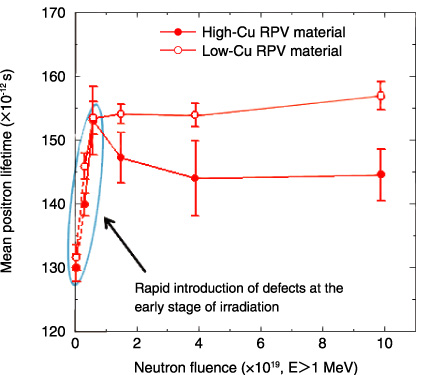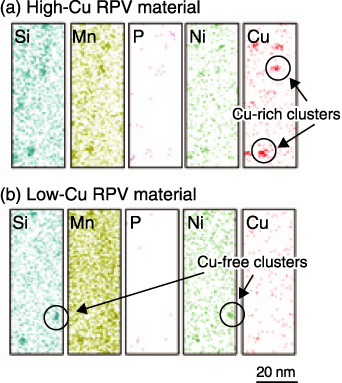
Fig.6-8 Mean positron lifetimes as a function of neutron fluence

Fig.6-9 Solute clusters observed by 3DAP
The first generation of domestic nuclear power plants has already been in operation for 40 years, and such long-term operation will increase in the near future. Although long-term service of existing plants is desirable from the viewpoints of global warming and the stable supply of energy, the most important factor is to assure the safety of the plants. Nuclear power generation is accompanied by neutron emission from the reactor core. The reactor pressure vessel (RPV), therefore, tends to become brittle due to neutron irradiation, resulting in reduction in its service life.
The degree of neutron irradiation embrittlement is generally evaluated by mechanical tests on specimens made from the RPV materials and inserted in the RPV. Prediction of future embrittlement is performed based on the trend curve of embrittlement with respect to neutron fluence. However, since the main causes of embrittlement are considered to be neutron irradiation-induced defects (i.e., fine displacement of atoms and voids) and clusters (i.e., nano-scale aggregations of atoms), microstructural observations are necessary to understand the embrittlement mechanism. An embrittlement prediction method using information from microstructural observations of irradiated RPV materials has now been incorporated in the domestic code for testing RPV materials.
We are conducting research to clarify the mechanism of neutron irradiation embrittlement using positron annihilation lifetime spectroscopy (PALS) and three-dimensional atom probe tomography (3DAP), which are methods for analyzing nano-scale structures in materials. PALS can provide information on the kinds and amounts of defects. Irradiation experiments with a high neutron flux were performed using two kinds of materials with high- and low-Cu contents in the Japan Materials Testing Reactor. For the first time, this revealed a rapid introduction of defects at the early stage of irradiation (Fig.6-8). Moreover, 3DAP can observe clusters. Cu is considered to play a central role in clustering, and Cu-rich clusters were observed in the high-Cu material. In addition, it was also revealed that Cu-free clusters were formed in the low-Cu material (Fig.6-9). Although the mechanical tests suggest that the magnitude of neutron embrittlement is roughly proportional to the Cu content of the materials, the nano-scale observations suggest the necessity of predicting neutron embrittlement while considering clustering even in low-Cu materials.
We aim to further improve the prediction of embrittlement of RPVs in order to contribute to their safe, long-term service.